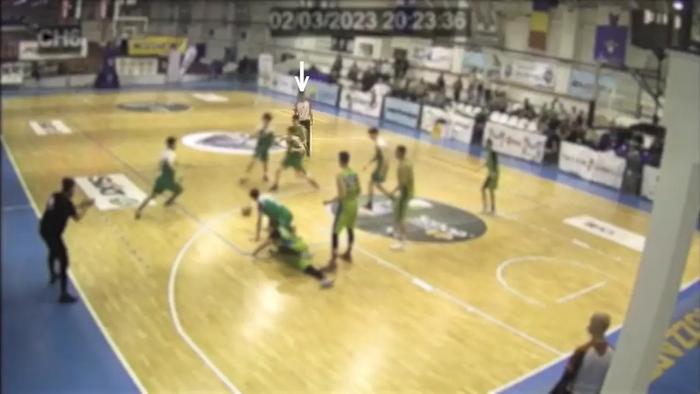Cardiovascular
Commotio cordis is real and awareness can save lives, experts say
video:
Initially, there is a scramble for a loose ball and player M.V. (large white arrow) is struck in the chest by the elbow of an opponent. M.V. stumbles but remains upright for a few seconds just prior to full collapse in cardiac arrest.
view more
Credit: Heart Rhythm Case Reports
Philadelphia, November 20, 2023 – A new case report appearing in Heart Rhythm Case Reports, an official journal of the Heart Rhythm Society, published by Elsevier, details the commotio cordis event experienced by a Romanian basketball player that resulted in cardiac arrest. The case is unique because it is validated and documented by an ECG and video evidence of the event. Swift action by onlookers saved his life.
In early January 2023, commotio cordis received substantial visibility and notoriety as the underlying cause of cardiac arrest when Damar Hamlin, a defensive player for the Buffalo Bills, was struck in the chest during a collision with an opponent in a US NFL professional football game. Rapid cardiopulmonary resuscitation (CPR) and defibrillation were lifesaving, with the event witnessed by millions on television in real time.
In Bucharest, Romania, 60 days later and 5,000 miles away, another commotio cordis event occurred, this time during a youth basketball tournament game witnessed only by families and friends. An 18-year-old basketball player (M.V.) was hit in the chest by an inadvertent light blow from an opponent’s elbow and collapsed during the game, which was filmed and documented. Rapid CPR and one defibrillation shock saved his life.
Commotio cordis events have been reported globally in more than 20 countries, but are extraordinarily rare and virtually always counterintuitive, as in M.V.’s case. In commotio cordis, ventricular fibrillation is precipitated by a blow over the heart and requires a precise timing to a narrow 20 ms window at the upstroke of the T wave.
After the commotio cordis event, M.V. was examined at Lahey Hospital and Medical Center in Burlington, MA, USA, by a team led by Barry J. Maron, MD.
Dr. Maron explains, “There is some skepticism regarding the existence of commotio cordis. Since the case of the Romanian basketball player was recorded and documented, it validates the existence of commotio cordis. It is a real phenomenon, and it occurs in real people in sports and in daily living. It is important to raise awareness of this condition, which is reversible with prompt intervention, as this case demonstrates.”
Prior to the event, M.V. was completely healthy without cardiovascular complaints; there is no family history of cardiovascular disease. When evaluated at Lahey Hospital and Medical Center six weeks after his cardiac arrest, he was asymptomatic and neurologically intact, without residual medical problems, and had begun to resume normal daily activities without difficulty.
The commotio cordis event reported here is notable for expanding the clinical spectrum of commotio cordis, given that competitive basketball previously had not been associated with this cause of cardiac arrest. Contact sports such as baseball/softball and hockey have dominated commotio cordis, owing to the greater possibility of physical contact and chest blows from hard-core projectiles (e.g., balls and pucks).
Dr. Maron concludes, “In this report, we have underscored once again that commotio cordis can occur under virtually any circumstance where there is the possibility of physical bodily contact of any magnitude, or projectile-induced chest blows, but always when least expected. This may be the best documented case we have of commotio cordis, which should go a long way to dispel skepticism.”
Journal
HeartRhythm Case Reports
Method of Research
Case study
Subject of Research
People
Article Title
Commotio cordis…once again: Unusual occurrence in a noncontact sport
Article Publication Date
13-Nov-2023
Disclaimer: AAAS and EurekAlert! are not responsible for the accuracy of news releases posted to EurekAlert! by contributing institutions or for the use of any information through the EurekAlert system.

